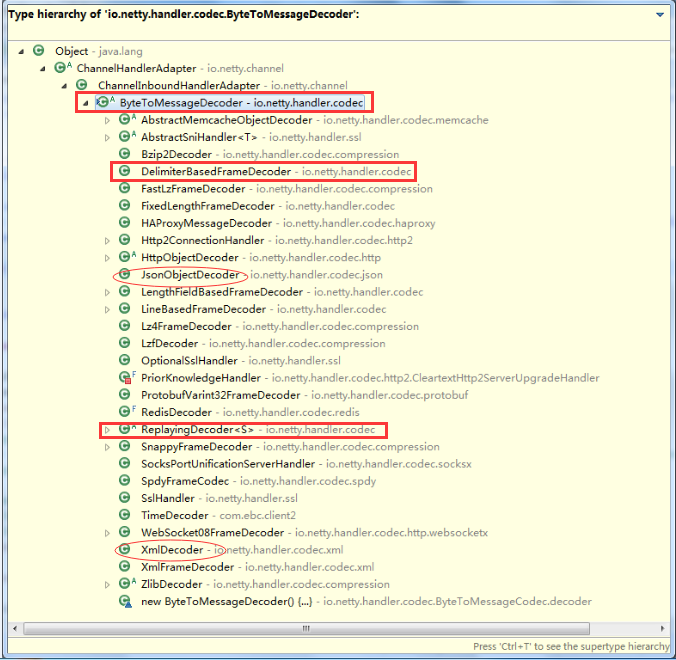TCP/IP,传输的是byte[],将byte[]放入队列中。可能会发生粘包和拆包。
比如,客户端向服务端发送了2条消息,分别为D1,D2,可能产生的情况,如下图所示:

情况一:正常的。
情况二:粘包。
情况三:拆包。即:部分数据不是一次完整发送的,而是分了至少2次发送。
如本例,D2拆成了D2_1和D2_2,这是拆包。
服务端分2次收到包,第一次收到了D1和D2_1包,这是粘包;服务端第二次收到了D2_2包,这是拆包。
回到Time client例子,存在相同的问题。4字节的int很小,很少发生粘包或拆包。但是,如果并发量大时,可能会发生。
最简单的方法是创建一个内部全局的(只为了多次接收放入相同buffer)buffer,等待,直到4个字节全部接受。以下修改了TimeClientHandler解决此问题。
第一种解决方法:全局buffer,累积。
import io.netty.buffer.ByteBuf; import io.netty.channel.ChannelHandlerContext; import io.netty.channel.ChannelInboundHandlerAdapter; import lombok.extern.slf4j.Slf4j; import cn.hutool.core.date.DateUtil; @Slf4j public class TimeClientHandler extends ChannelInboundHandlerAdapter { private ByteBuf buf; @Override public void handlerAdded(ChannelHandlerContext ctx) throws Exception { buf = ctx.alloc().buffer(4);//(1) } @Override public void handlerRemoved(ChannelHandlerContext ctx) throws Exception { buf.release();//(1) buf = null; } @Override public void channelRead(ChannelHandlerContext ctx, Object msg) throws Exception { ByteBuf m = (ByteBuf) msg; buf.writeBytes(m);//(2) m.release(); if (buf.readableBytes() >= 4) {//(3) long currentTimeMillis = (buf.readUnsignedInt() - 2208988800L)*1000L; log.info("{}",DateUtil.date(currentTimeMillis)); ctx.close(); } } @Override public void exceptionCaught(ChannelHandlerContext ctx, Throwable cause) throws Exception { cause.printStackTrace(); ctx.close(); } }
1、ChannelHandler
- ChannelHandler有2个监听器方法(生命周期):handlerAdded()和handlerRemoved()。当该handler被添加到pipeline中时,被触发;当该handler从pipeline删除时,被触发。该handler,执行顺序:channelAdd()--->channelRead()--->channelRemove()。
- 只要任务不重,即不会阻塞很久,可以在这2个方法中做一些初始化的工作。比如本例,channelAdd()中初始分配一个4字节的ByteBuf,在channelRemove()中释放ByteBuf。
2、首先,接收到的所有字节均被写入buf。
3、然后,handler必须要检查是否够4个字节(本例),如果不够(拆包),则当有剩下的数据来时,Netty会再次调用该channelRead()方法,直到4个字节都接收到为止。
第二种解决方法:使用解码器
尽管第一种方法解决了粘包和拆包问题,但是,代码臃肿。因为,可以向pipeline中添加多个handler,因此,我们可以将TimeClientHandler分割成2个handler:
1)、TimeDecoder
2)、上节里的TimeClientHandler版本。
TimeDecoder.java
import java.util.List; import io.netty.buffer.ByteBuf; import io.netty.channel.ChannelHandlerContext; import io.netty.handler.codec.ByteToMessageDecoder; public class TimeDecoder extends ByteToMessageDecoder {//(1) @Override protected void decode(ChannelHandlerContext ctx, ByteBuf in, List<Object> out) throws Exception {//(2) if (in.readableBytes() < 4) { return ;//(3) } out.add(in.readBytes(4));//(4) } }
1、ByteToMessageDecoder 实现了ChannelInboundHandler

2、ByteToMessageDecoder,当调用decode()时,其内部实现了“累积”功能的buffer,即不用自己在写全局buffer了,当接收到新数据时,会向该buffer中写入。
3、decode():比如,一个包分2次传的,则会调用2次decode()。第一次即使不够4个字节,也会存入其内部“累积”buffer。我们的decode()方法中,return即可。
4、decode()中,一旦添加了一个obj到“out”,意味着该decoder已经成功将消息解码了,即解决了粘包拆包问题。此时,ByteToMessageDecoder将会丢弃掉“累积”buffer中已读的消息。ByteToMessageDecoder将会不断调用decode(),直到添加“空”到out为止。
TimeClientHandler.java(上节time中的TimeClientHandler)
import io.netty.buffer.ByteBuf; import io.netty.channel.ChannelHandlerContext; import io.netty.channel.ChannelInboundHandlerAdapter; import lombok.extern.slf4j.Slf4j; import cn.hutool.core.date.DateUtil; @Slf4j public class TimeClientHandler extends ChannelInboundHandlerAdapter { @Override public void channelRead(ChannelHandlerContext ctx, Object msg) throws Exception { ByteBuf m = (ByteBuf) msg; try { long currentTimeMillis = (m.readUnsignedInt() - 2208988800L)*1000L; log.info("{}",DateUtil.date(currentTimeMillis)); ctx.close(); } finally { m.release(); } } @Override public void exceptionCaught(ChannelHandlerContext ctx, Throwable cause) throws Exception { cause.printStackTrace(); ctx.close(); } }
然后,
@Override protected void initChannel(SocketChannel ch) throws Exception { ch.pipeline().addLast(new TimeDecoder(),new TimeClientHandler()); }
执行顺序:TimeDecoder.decode(ctx, ByteBuf in, List<Object> out)--->TimeClientHandler.channelRead(ctx, Object msg)。
上例中,从TimeDecoder传给TimeClientHandler的依然是ByteBuf,既然是int,那我们可以直接传递int吗?可以,如下:
TimeDecoder.java,修改成
protected void decode(ChannelHandlerContext ctx, ByteBuf in, List<Object> out) throws Exception {//(2) if (in.readableBytes() < 4) { return ;//(3) } //out.add(in.readBytes(4));//(4) out.add(in.readUnsignedInt());//(4) }
TimeClientHandler.java,修改成
@Override public void channelRead(ChannelHandlerContext ctx, Object msg) throws Exception { long m = (long) msg; long currentTimeMillis = (m - 2208988800L)*1000L; log.info("{}",DateUtil.date(currentTimeMillis)); ctx.close(); }
ReplayingDecoder是一个更加简单的decoder。可以代替ByteToMessageDecoder,只需要修改TimeDecoder,如下:
import io.netty.buffer.ByteBuf; import io.netty.channel.ChannelHandlerContext; import io.netty.handler.codec.ReplayingDecoder; import java.util.List; public class TimeDecoder extends ReplayingDecoder<Void> {//(1) @Override protected void decode(ChannelHandlerContext ctx, ByteBuf in, List<Object> out) throws Exception {//(2) out.add(in.readUnsignedInt()); } }
其他代码都不用动。
最终输出:
服务端:18:43:45.824 [nioEventLoopGroup-3-4] -549056671
客户端:
18:43:45.854 [nioEventLoopGroup-2-1] 2018-09-14 18:43:45
18:43:45.929 [main] client channel is closed.